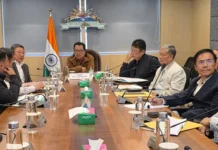[ Bengia Ajum ]
The arrest of a lawyer and an activist for defacing the mural painting on the boundary wall of the state civil secretariat with a ‘no big dam’ message and a resistance logo has brought the hydropower issue to the forefront once again.
The social media circle is witnessing fierce debates with both pro-dam and anti-dam supporters strongly presenting their views. The hydropower dam issue has always divided opinions in the state.
It was under late chief minister Dorjee Khandu that the state started the effort to tap the hydro potential of Arunachal in a big way. While the majority of the projects have failed, some are still in the offing, especially those being taken up by public sector undertakings (PSU).
In the Siang and Dibang basins, the locals had strongly resisted major dams. However, the resistance has faded over the years. But a section of the population still continues to resist. The state government sees hydropower, along with the tourism sector, as the main source of revenue and employment generation. For a state which depends on central funds for development, these two sectors are seen as saviours. But does it really help the local population and the state government? This is debatable.
Well, let me share a personal experience. During my initial years, I grew up in Chun village, near Yazali in Lower Subansiri district. My mother, who belongs to the Taba clan, is from Chun village, and I was raised by my uncles and aunties in Chun village.
Today the village no longer exists. It was located just below the present Ranganadi hydroelectric project dam, popularly known as the NEEPCO dam, at 43 Km, near Yazali.
After the dam came up, the villagers were shifted to the present-day Potin village as part of the rehabilitation process. But hardly anyone benefitted from the project. No proper compensation was paid and very few got jobs under the NEEPCO.
The people of Chun suffered a lot. Starting a new life in Potin was a struggle and many could not recover from the relocation process and went into poverty. Also, the majority of the employees of the NEEPCO are from outside Arunachal and the locals have not really benefitted much from the project. These hydro developers have no love for the local people and the state. They just want to use the resources and are here for the profit motive.
With the locals hardly getting any benefits, the people will turn against these projects. Further, wherever the citizens are against such projects, the state government should not forcibly impose upon them. Too many dams will also harm the environment of the state in the long run.
Deputy Chief Minister Chowna Mein recently informed the state assembly that the government has terminated 44 memorandums of agreement (MoA) with private power developers “for their non-serious and inconsistent nature.” The government is contemplating handing them over to a PSU.
Instead of handing over these projects to PSUs, the state government should contemplate handing over some of them to the Hydro Power Development Corporation of Arunachal Pradesh Limited (HPDCAPL), the state-owned entity, if it is really serious about tapping the hydro potential of the state. The HPDCAPL should be strengthened and allowed to take up projects single-handed or in joint ventures. This will benefit the state and its citizens in the true sense. If not, the story of Chun village will continue to be repeated across Arunachal.
The private developers, as well as the PSUs, are here for profit and hardly care about the local population. The indigenous tribal population of the state has the first right over the resources. The state government will have to fiercely protect its interests and stop the hydropower developers from looting the resources of Arunachal Pradesh.
Even though I have settled down in Poma village in Papum Pare district, the memories of Chun village, where I spent a large part of my early childhood, remain fresh – especially the time I spent with my maternal grandmother. I wish to someday visit and see whether the grave of my grandmother still exists.



